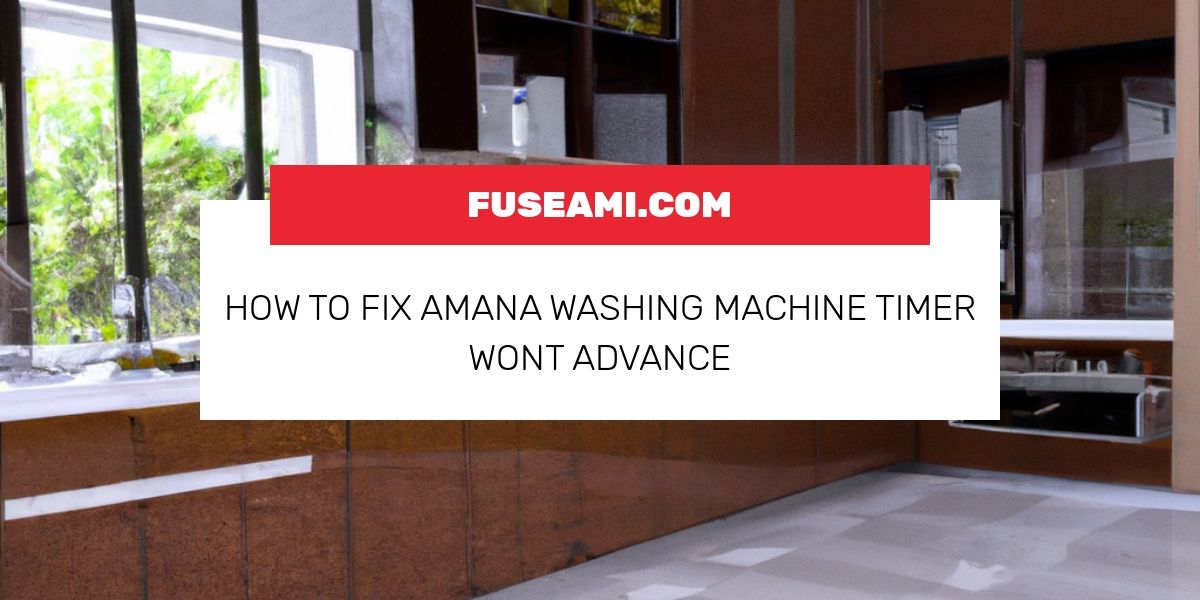It’s frustrating and time-consuming to repair an issue with a Amana washing machine that doesn’t start. Fortunately, there are several ways to troubleshoot and resolve the problem. In this article, we will discuss the causes that are common to the Amana washing machine’s timer which won’t advance, and provide step-by step instructions on how to fix the problem. No matter whether you’re a skilled DIYer or are new to DIY, this guide will assist you in getting your Amana washing machine up and working again in no time.
Lid switch
The lid switch is a safety option on top loading Amana washing machines. The lid switch is usually placed beneath the main top with an opening on the lid or a pin that is attached to the lid which triggers the switch once the lid is closed. The lid switch is the source of power to the timer and motor circuits. How do you test the lid switch on an Amana washing machine with the multimeter
- Unplug the power source to your Amana washing machine.
- Find the switch on the lid by taking off the top panel or cabinet.
- After finding the switch, you must begin by making sure that the levers and actuators have been damaged or stuck and that the switch is being engaged mechanically whenever the lid is shut.
- If there is nothing wrong in the tests above, you can remove the switch and alter the Rx1 setting of your multimeter. When you press and hold the switch button, place probes on the switch’s terminals. You should see a reading that is zero.
- If you see a different reading, you’ll need a replacement lid switch.
Timer and Motor
The timer controls all features of the Amana washer. The timer comes with several electrical contacts which are controlled by a cam assembly which is controlled by a timer motor. The timer motor is controlled by certain of the contacts. The timer motor may be damaged if the washer’s timer does not move. Test the timer & timer motor on the Amana washing machine with a multi-meter
- Disconnect the power source of your Amana washing machine from the source of power.
- Locate and then remove the timer from the appliance. You’ll have to take out the control panel as well as the rear panel to access it.
- Use your multimeter to touch the probes at the motor’s terminals (refer to your wiring diagram). The test for continuity should yield a value of zero to nearly zero.
- You’ll need to purchase a replacement timing timer if your test gives you different results.
Control of water level
The water level control feature on Amana washing machines allows you to turn on or off the water valve when it reaches certain levels and to also supply power to the motor to alter the water level. If your washer fills but the timer does not advance , it could be due to a defective water level switch. How to inspect the control of water levels in an Amana washing machine
- Since you will work using electrical parts, it is crucial to disconnect the washing machine before you start.
- Prior to suspecting the switch prior to identifying the problem, you should remove the air dome hose as the cause of the problem. To locate and remove the air dome hose, pull out the cabinet. The hose should be placed in water and close the ends. In the next step, blow air over the ends to look for bubbles. You should also inspect the hose for wear, cracks, or obstructions.
- If you’ve not encountered any issues, you might require a new water-level switch.
Timer Knob & Dial and Skirt
The timer dial or knob is connected to the shaft of the timer and is able to rotate as the timer advances through a sequence. You can also pull the knob to trigger an internal switch inside the timer. The timer knob is usually made of plastic and reinforced by a keyed-in insert. The knob is susceptible to cracking or wear over time and stop rotating with the shaft. This makes it more difficult to set the timer for the desired cycle. It will also cause the dial not to move with the shaft as the cycle progresses. How to check the timer knob on the Amana washing machine:
- Unplug your Amana washer from the source of power.
- Find the knob for the timer It is necessary to remove the rear panel or cabinet in order to reach the inside of the timer.
- To make sure the timer is engaged examine the knob by taking it out and pressing in.
- If it doesn’t engage it, you’ll need new knobs.
Drain Pump
A drain pump is a machine that removes water from the Amana washer tub after the rinse and wash portion. If the drain pump fails, the Amana washing machine will not know that the tub is empty and might not be able to advance to the next stage of the cycle. If your washing machine stops after the wash or rinse portions of the cycle, you should verify that the drain pump is operating correctly. Some models controlled electronically may show a fault signal in the event of this. To find out the cause behind your Amana washing machine flashing a fault code, we suggest you refer to our list. How to inspect drain pump inside the Amana washing machine.
- Unplug your Amana washing machine.
- Locate your drain pump. It’s necessary to take off the front panel or cabinet of the appliance in order to reach the pump.
- After you’ve located the pump, look over the connections and hoses coming out of the pump for any damages or leaks.
- If the leak is coming from the pump, then you’ll require a new pump.
Water Inlet Valve
The water valve that is inlet to supply both cold and hot water to the Amana washer during fill portions of the cycle. At least two solenoids from an electric source are required to open the valve. If your washer does not move through the cycle, or is unable to move through the wash or rinse fill portion, then the water inlet valve may be at fault. First, you should ensure that the inlet hoses aren’t have any kinks or restrictions and that the inlet screens are clear. If these are ok You can then test the integrity of the solenoids by using the help of a multi-meter. How to test the water inlet valve inside an Amana washing machine with a multi-meter:
- Check that you have disconnected the Amana washing machine before starting.
- Find and remove the valve for water inlet. You’ll find it right behind the hose connectors. To reach it, you will need to take down all or part the cabinet.
- You should inspect the screens of the valve for any obstructions or buildups. If they are damaged, you’ll have to replace them.
- If you observe damage or wear to your pump, turn on your multimeter before attaching the probes to appropriate terminals. Check your manual for details on what this test can reveal because it is different between models. next.
- You’ll need to purchase a water valve replacement in the event that your readings are not within the range of recommended.



